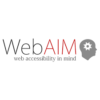Web Accessibility
Web Site Marketing
WCAG stands for the Web Content Accessibility Guidelines. The Web Content Accessibility Guidelines are arguably the most influential protocols shaping web accessibility policy.
Why should you care about WCAG compliance?
Approximately 16% of the world’s population lives with some form of disability. Unfortunately, the vast majority of websites and online environments are designed without the unique needs of members of the disability communities in mind. When attempting to engage with websites, people with hearing, vision, cognitive, motor, and other disabilities and impairments are likely to be met with digital barriers that others do not face.
The Web Content Accessibility Guidelines (or WCAG for short) were created to help amend this unjust situation. Comprehensive and highly in-depth, WCAG is composed of numerous guidelines and success criteria by which websites and web-based applications are considered accessible to people with disabilities.
If it meets WCAG requirements at a certain level, your website will be deemed accessible, legally speaking.
This will result in your audience expanding to include groups that are too often underserved, and will also help you meet legal obligations you may be mandated to.






























